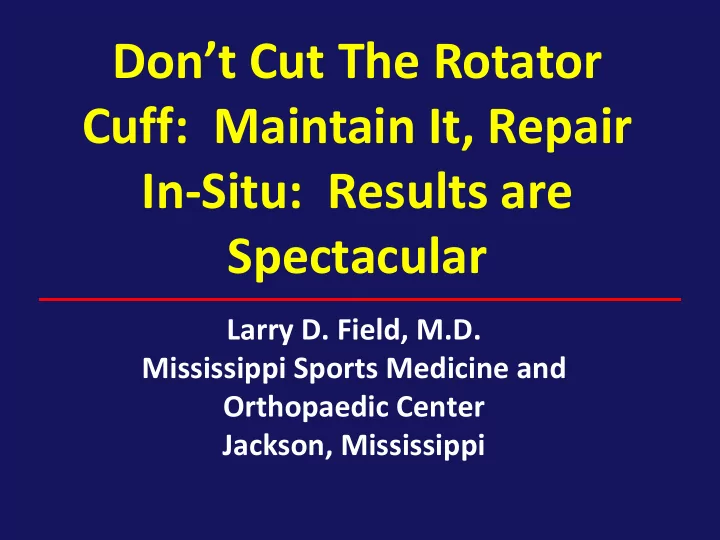

Don’t Cut The Rotator Cuff: Maintain It, Repair In-Situ: Results are Spectacular Larry D. Field, M.D. Mississippi Sports Medicine and Orthopaedic Center Jackson, Mississippi
Disclosures The following relationships exist: 1.Royalties and stock options None • 2.Consulting income Smith & Nephew • 3.Research and educational support Arthrex • Mitek • Smith & Nephew • 4.Other support None •
Partial Thickness Rotator Cuff Tears • Despite PRCTs occurring very commonly – Identifying tears challenging – Defining extent difficult – Treatment controversial
Classification • Ellman (1990) – Grade I <25% (<3 mm) – Grade II 25 – 50% (3 – 6 mm) – Grade III >50% (>6 mm) • Snyder – Location A (articular) and B (bursal) – Severity 0 - 4
PRCT Types • Articular – Degenerative – 2 ° internal impingement Repetitive contact Tight posterior capsule Lax anterior capsule • Bursal – Outlet impingement • Intratendinous – Traction (tensile overload) – Degenerative
Operative Treatment Decision making for PRCTs • Factors to consider – Depth of tear − Articular or bursal – Patient age – Activity level – Associated pathology
Measuring Depth of Tear NORMAL CUFF PARTIAL ARTICULAR TEAR
Operative Treatment • Debridement of PRCTs more commonly performed in overhead athletes – “Less is More” concept • Repair indicated in some patients • A. Complete tear then repair? • B. I n-situ (trans-tendon) repair? • C. Patch?
Debridement vs. Repair • Tears <3 mm (A1 or B1) – Debridement • Larger tears don’t heal – Yamanaka 1994 • 80% of 40 articular tears progressed arthrographically • Tears >50% often repaired – Complete tear vs. In-situ repair – Near complete (~95%) tears best completed then repaired—”take down the tear” • Very limited intact rotator cuff tissue
Near Complete PRCTs
Completing RC Tear “Risky” • Marking suture helpful in localizing adjacent bursal RC – Commonly performed • Marking suture must be placed accurately • Non-anatomic “RC take down” creates improper iatrogenic tear RC Cable – “Take down” is a blind technique • Subacromial space view with shaver blade • Inadvertent damage to intact RC cable or biceps tendon Biceps
“Poor Marksman”
In-situ Repair Proven Technique • Snyder et al 1999 • Lo and Burkhart 2004 (Arthroscopy) • Ide et al 2005 (AJSM) • Waibl and Buess 2005 (Arthroscopy) • Castagna et al 2009 (AJSM) • Shin 2012 (Arthroscopy) • Kim at al 2013 (Knee Surg Tr. Arth) • Franceschi et al 2013 (Int Orthop) • Vinanti et al 2016 (Knee Sports)
Results • Shin, Arthroscopy 2012 – Prospective, randomized study • 48 patients (24 in each group) • >50% partial articular tears • Trans-tendon vs. “take down” • No differences in functional outcomes • Post-op MRIs – 2 re-tears in tendon “take down” group – No re-tears in trans-tendon repair group
Biomechanical Superiority Of In-situ Fixation • Gonzalez (JSES 2008) – Cadaveric 50% tears created – In-situ repair stronger • Mazzocca (AJSM 2008) – Intra-articular strain normalized after in-situ repair • Sethi (Orthopaedics 2013) – Bursal RC strain lower with in-situ repair SETHI et al
In-Situ Repair Technique Requirements • Adequate intact tendon (≥25%) • Intact tendon healthy after debridement
In-Situ Repair Technique • Reapproximate footprint anatomically to minimize tension mismatch Rudkzi 2008
In-situ Repair Technique • Lateral oriented suture angle reduces tension mismatch • Retrograde suture passage aids repair • Improved biceps view helps avoid incarceration
Arch Orthop Trauma Surg 2016
Summary • Careful arthroscopic assessment important • Debridement alone for Type I partial tears • Large partial tears do not heal and often enlarge • Several repair techniques successful • In-situ PRCT repair technique – Lower re-tear rates in some studies – Significant biomechanical advantages – Reduces risk to healthy RC tendon and biceps
Heal It, Don’t Peel It!
Thank You
Recommend
More recommend